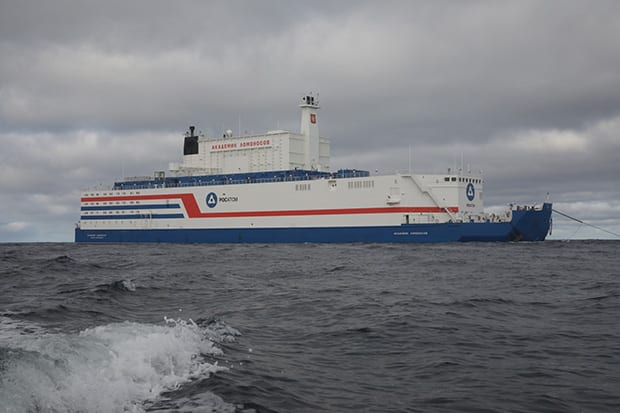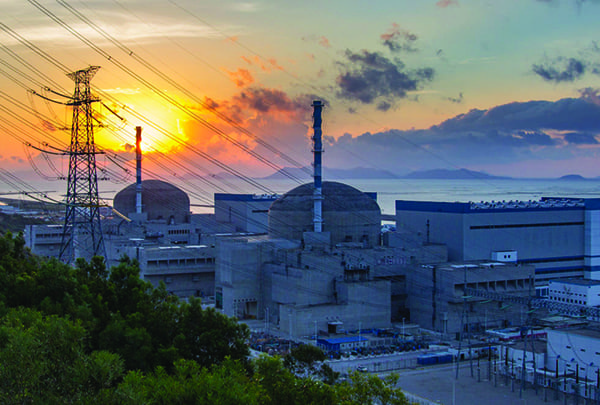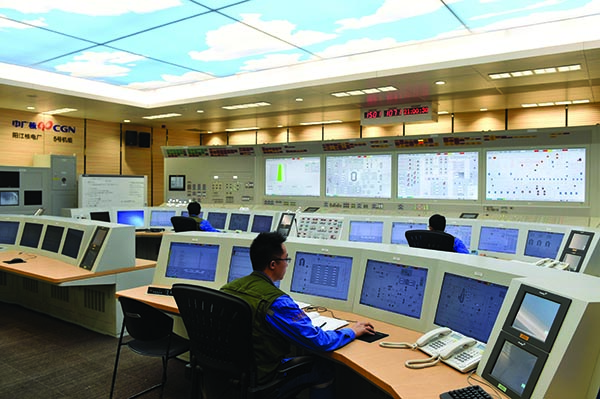Top 6 Nuclear Power Achievements of the Year
Credit to Author: Aaron Larson| Date: Thu, 26 Dec 2019 11:34:04 +0000
The post Top 6 Nuclear Power Achievements of the Year appeared first on POWER Magazine.
The past year has been filled with firsts for the nuclear power industry. Three power plants sporting first-of-a-kind reactors entered commercial operation, while the first U.S. AP1000 nuclear project reached key milestones on its path to completion. Furthermore, the U.S. Nuclear Regulatory Commission (NRC) granted the first early site permit for a utility to construct small modular reactors (SMRs) and finished the fourth phase of its first SMR design certification review, keeping NuScale Power on track to have its first SMR in operation by the mid-2020s.
World’s First EPR Nuclear Power Plant Enters Commercial Operation
Technically, Taishan Unit 1—the first Evolutionary Power Reactor (EPR) unit to be connected to the power grid—entered commercial operation on Dec. 18, 2018, but Unit 2 followed suit on Sept. 7, 2019, giving the combined facility a place on this list. The pressurized water reactor (PWR) units are notable as the most-powerful reactors currently operating in the world, and the station was selected as a POWER Top Plant in 2019.
Excavation work for the Taishan nuclear station (Figure 1) in Guangdong province, China, began in 2008. EDF subsidiary Framatome supplied the third-generation technology, which is also being installed at Olkiluoto 3 in Finland (under construction since August 2005) and at Flamanville 3 in France (under construction since December 2007).
| |
| 1. Taishan Nuclear Power Plant. Courtesy: EDF |
Cost overruns and schedule delays have plagued all the EPR units, but the trouble hasn’t kept the technology from being selected for other projects. In July 2016, EDF announced it would construct two EPR reactors at Hinkley Point C in Somerset, England. EDF and China General Nuclear Power Group (CGN) are also partnering on the Sizewell C project in the UK, which will have two similar units. In March 2018, EDF inked a deal with India’s state-owned nuclear operator, Nuclear Power Corp. of India Ltd., setting out the industrial framework for a massive six-unit, 9.9-GW project utilizing EPR technology. That facility will be the world’s largest nuclear power plant, if completed as planned.
World’s First ACPR-1000 Nuclear Power Plant Begins Commercial Operation
Yangjiang Unit 5—the first ACPR-1000 (Advanced Chinese PWR) unit to enter service—actually began operation in 2018. However, Unit 6 went commercial in August 2019, warranting inclusion on this top-achievements list. Completion of the first ACPR-1000 reactors at Yanjiang marked a major accomplishment for China in its efforts to commercialize the 1,000-MW evolutionary third-generation nuclear reactor. Like Taishan, the facility was recognized in 2019 with a POWER Top Plant award.
According to “Advanced Large Water Cooled Reactors,” a booklet published by the International Atomic Energy Agency, the ACPR-1000 was designed by CGN based on the CPR-1000 (Improved Chinese PWR), which in turn was based on the 900-MWe, three-loop, French M310 plant. The ACPR-1000, however, retains full Chinese intellectual property rights.
The Yangjiang facility has evolved into a major demonstration site for CGN. Yangjiang 1 and 2 feature CPR-1000 technology. Those units were brought online in March 2014 and June 2015, respectively. CGN then made more than two dozen safety and technical modifications to the CPR-1000 design, and created the CPR-1000+, which was utilized in Yangjiang Units 3 and 4. Now, the ACPR-1000 is showcased in Units 5 and 6. Furthermore, the latest units are the first to adopt a nuclear-grade distributed control system (Figure 2), known as FirmSys, which was developed by China Techenergy Co. (CTEC), a CGN subsidiary.
| 2. CTEC delivered the nuclear-grade DCS equipment to Yangjiang in November 2016 after spending two years on a $15 million prototype project to ensure the integrity, reliability, and performance of the platform. Courtesy: CGN |
CTEC’s success at Yangjiang, has led to FirmSys being installed at the Shidao Bay high-temperature gas-cooled reactor, and at CGN’s Hongyanhe, Tianwan, and Fangchenggang sites. The company claims the technology can save 3 billion yuan ($424 million) in construction costs.
Akademik Lomonosov Connects to Grid
The floating power unit (FPU) Akademik Lomonosov was connected to the power grid and began generating electricity for the first time in the isolated Chaun-Bilibino network in Pevek, Chukotka, Russia’s Far East, Rosatom—the country’s state nuclear corporation—reported on Dec. 19. The nuclear FPU is equipped with two KLT-40C reactor systems (each with a capacity of 35 MW) similar to those used on icebreakers. The vessel is 144 meters long and 30 meters wide, and has a displacement of 21,000 metric tons (Figure 3).
 |
| 3. Akademik Lomonosov’s keel was laid in April 2007 at Sevmash in Severodvinsk, northwestern Russia, but the project was subsequently transferred to Baltiysky Zavod, one of Russia’s oldest shipyards, located in St. Petersburg. The FPU was towed 4,000 kilometers (km), around Finland and Sweden, to Murmansk for fuel loading in May 2018. In August 2019, it was towed by two tugboats to the Arctic port town of Pevek, a distance of 4,700 km, arriving safely in mid-September. Courtesy: Rosatom |
Akademik Lomonosov—the first ship of its kind—was named for 18th century Russian scientist Mikhail Lomonosov. Rosatom said Akademik Lomonosov is a pilot project and a working prototype for a future fleet of floating nuclear power plants and onshore installations based on Russian-made SMRs. The small power units are expected to be deployed in hard-to-reach areas of Russia’s North and Far East regions, and exported around the world.
“After its connection to the grid, Akademik Lomonosov becomes the world’s first nuclear power plant based on SMR-class technology to generate electricity,” Rosatom’s Director General Alexey Likhachev said in a press release. “This is a remarkable milestone for both the Russian and the world’s nuclear energy industry.”
The reactors will also connect to Pevek’s heat supply networks. That work is expected to be completed in 2020.
Vogtle Nuclear Expansion Progresses
Georgia Power reported on Dec. 16 that the main control room for Vogtle Unit 3 was placed in operation and plant systems testing was in progress, marking a significant milestone at the site. “Bringing the Unit 3 main control room online is another major step in the project’s transition from construction to system operations,” Vogtle 3 and 4 Construction Executive Vice President Glen Chick said in a press release. “The main control room allows us to conduct systems testing of the unit in preparation for initial start-up.”
Other notable milestones reached on Unit 3 in 2019 included setting the containment vessel top head; completing various integrated flush activities, which clean and remove foreign material from piping and mechanical components that feed into the reactor vessel and reactor coolant loops; commencing open vessel testing, which demonstrates how water flows from key safety systems into the reactor vessel ensuring the paths are not blocked or constricted; and placing the 1,000-ton shield building roof (see video below). Meanwhile, Georgia Power reported in October that all 1,485 major modules needed to construct Units 3 and 4 have been received at the site near Waynesboro, Georgia.
Check out this time-lapse of the two-million-pound shield building roof being set into place at Plant Vogtle Unit 3! pic.twitter.com/YM4MpBzGL7
— Georgia Power (@GeorgiaPower) December 10, 2019
The project was 79% complete on June 30, according to Georgia Power’s most-recent Vogtle Construction Monitoring Report filed with the Georgia Public Service Commission in August. Southern Company CEO Thomas Fanning seemed confident on Oct. 30 that the Vogtle expansion would be completed in accordance with its current schedule. “We remain focused on meeting the November 2021 and November 2022 regulatory-approved in-service dates, and we continue to maintain an aggressive work plan on-site as a tool to help position us to meet those dates,” he said during the company’s earnings call held that day.
NRC Approves Clinch River Nuclear Site for SMRs
In mid-December, the Tennessee Valley Authority (TVA) received approval from the NRC for an early site permit to potentially construct and operate SMRs on a 935-acre Clinch River site near Oak Ridge, Tennessee. TVA applied for the permit in 2016, and the NRC began formally reviewing the 8,000-page application in January 2017.
The application addressed the site safety, environmental, and emergency preparedness requirements to determine site suitability. The approved permit allows construction of up to an 800-MW nuclear facility. TVA will have 20 years, or more with a possible extension, to consider pursuing construction of SMRs.
“The early site permit is a significant step in the potential development of small modular reactor technology,” Dan Stout, director, nuclear technology innovation at TVA, said in a statement. “Although we have no plans to build at this time, this permit will give TVA flexible options to prepare for future energy needs.”
NuScale’s SMR Design Clears Phase 4 of NRC Review Process
Also, in mid-December, NuScale Power announced that the NRC completed the fourth phase of review of the design certification application for the company’s SMR. The milestone marked a significant achievement in the unit’s path to commercialization.
“The completion of Phase 4 of the NRC’s design review certification process is an unprecedented step forward for our company and for the advanced nuclear industry overall,” NuScale CEO John Hopkins said in a press release. “We appreciate the tremendous effort the U.S. Nuclear Regulatory Commission has dedicated to its thorough and rigorous review of our groundbreaking technology thus far. We are thrilled to be entering into the final stages of the NRC’s review process and are looking forward to delivering America’s first small modular nuclear reactor.”
Phases 5 and 6 of the review remain, with those steps targeted for completion on June 23, 2020, and Sept. 8, 2020, respectively. Phase 5 entails a review by the NRC’s Advisory Committee on Reactor Safeguards (ACRS). The ACRS is an independent advisor to the NRC that reviews and reports on safety studies, and reactor facility license and license renewal applications. Phase 6 ends when there are no open items and the final safety evaluation report is issued.
NuScale’s first customer is expected to be Utah Associated Municipal Power Systems (UAMPS). UAMPS is a political subdivision of the State of Utah that provides comprehensive wholesale electric-energy, transmission, and other energy services, on a nonprofit basis, to community-owned power systems throughout the Intermountain West. It has members in Utah, California, Idaho, Nevada, New Mexico, and Wyoming.
UAMPS is planning a 12-module SMR plant in Idaho slated for operation by the mid-2020s based on the NRC’s certified design. NuScale has also signed deals to potentially deploy its technology in Canada, Jordan, the Czech Republic, and Romania, and similar agreements are being discussed with other potential customers.
Meanwhile, NuScale has also taken steps to develop its supply chain, signing preliminary agreements with various companies that will offer technical expertise and manufacture plant components. Among recent partners are Doosan Heavy Industries and Construction Ltd., which will bring its expertise in nuclear pressure vessel manufacturing and join the larger U.S.-led manufacturing team to build NuScale Power Modules, and Sargent & Lundy, which will proceed with development of the standard plant design and provide additional architect-engineer support.
—Aaron Larson is POWER’s executive editor (@AaronL_Power, @POWERmagazine).
The post Top 6 Nuclear Power Achievements of the Year appeared first on POWER Magazine.

